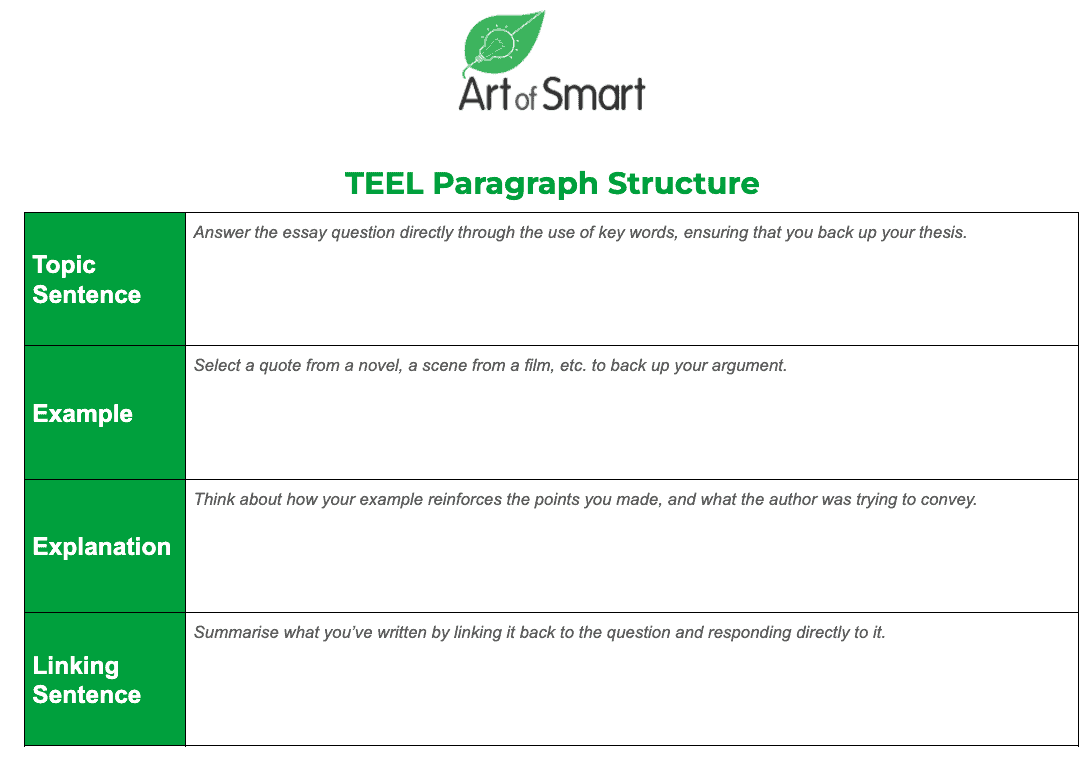Trying to work towards a Band 6 in HSC English, but are struggling with how to construct paragraphs well in your essays and need clearer examples? Don’t worry, because we’ll break down the TEEL paragraph structure for you right now!
Here’s the ultimate guide to writing a TEEL paragraph that you’re proud of, so you can get an awesome mark in English. You’ll discover our useful techniques for creating cohesive paragraphs.
So, what are you waiting for? Let’s get started!
What is TEEL and why should you use it?
Using TEE Tables
Constructing the Paragraph
Top 5 Rules to Remember when Constructing TEEL Paragraphs
What is TEEL and why should you use it?
Basically, the TEEL structure provides you with an organised method for getting your point across. Using the TEEL structure can help show your reader that you are able to clearly analyse and respond to a given text and question.
To see this, let’s break down the TEEL paragraph structure:
T for Topic Sentence
The very first sentence in your paragraph which gives the reader a good understanding of what you are going to talk about. It helps to directly respond to what the question is asking you here!
E for Example
In the example section of the paragraph, you are required to extract important quotes in your text to support you overarching theme and thesis.
In preparation for this part of your paragraph, highlighting, underlining, and annotating your text as you read it could serve you well.
E for Explanation
So you’ve got your examples written. Now it’s time to explain exactly why they relate to your theme in the explain section.
This will be the bulk of your paragraph. Over here, you will go into further detail, analysing and fleshing out any key points that you want to make.
L for Linking Sentence
Sum up your argument over here with your linking sentence. Highlight how your paragraph supports your overarching thesis/point.
Not sure how to find and use quotes in your English Essay? Check out our in-depth guide to embedding quotes.
It is also important to note that the TEEL paragraph structure is very generic, and as you go into older years, you’ll find that your paragraphs start to look more like TEEEEEEL paragraphs! This just means that your paragraphs will be packed full of examples and explanations, so you’re on the right track.
Pretty simple right? You’ll find that the more TEEL paragraphs you write, the more repetitive it gets.
But what happens if you’re in an exam and forget what you were going to write as your explanation or examples?
Using TEE Tables
To avoid sticky situations like these, it can be helpful to use TEE Tables to structure your arguments in a clear and logical manner.
To summarise, a TEE table is used as an organiser for the techniques, examples, and effects that you wish to analyse for a specific text.
In general, it is helpful to split up your TEE analysis into the various themes that you are exploring in your text.
Here is a sample TEE table for Ray Bradbury’s ‘The Pedestrian’, in reference to the theme of dehumanisation:
| Technique | Example | Effect |
|---|---|---|
| Symbolism | ... “The faintest glimmer of firefly light appeared in flickers behind the windows.” | Through symbolism here, Bradbury is referring to the television screens that most residents seem to be glued to, like fireflies to light sources. This highlights how individuals would rather rely on interpretations of the world illustrated on their T.V. screens rather than explore the world for themselves. |
| Truncated sentence | ... “No profession.” | In this short sentence, the police car is shown to dismiss Mead’s occupation as a writer. This exposes the loss of creativity and expression of thought in the protagonist’s restrictive society. |
| Dark imagery | “Tomb like building...” “…Walking through a graveyard” “Gray phantoms...” | Such imagery exposes the isolated and alienated nature of Mead’s city, suggesting the departure from a state of creativity and the slow takeover of technology and loneliness. |
The theme being analysed in this TEE table is dehumanisation, which is a motif that runs throughout Bradbury’s entire short story! By creating a TEE table, we have successfully analysed the text regarding this theme.
This table can be created for each of your themes and serves as an efficient way for you to organise all your techniques and quotes in a clear manner!
After creating these tables, the only thing left to do is put them in a TEEL paragraph format. Since we have our TEE tables for reference, our techniques and examples section of the paragraph is already down pat, and all that’s left to add is a solid thesis statement and a conclusion!
Incorporate some style in your essay by learning how to use persuasive techniques!
Constructing the Paragraph
We must ensure that the topic sentence, or thesis statement relates not only to the question, but also to the theme we will be exploring. A good topic sentence will try to incorporate both the theme and question in one succinct sentence.
Similarly, an effective linking sentence serves to sum up the points you have addressed in your TEEL paragraph while relating them back to the question.
For example, let’s use the TEE table created above to make a TEEL paragraph:
In this paragraph, each section has been highlighted for your convenience, TEEL being yellow, red, blue, and pink respectively.
And there we have it! We have successfully used our TEE table to create a succinct and clear TEEL paragraph which addresses a theme relevant to the text.
Remember, the key to perfecting your TEEL paragraph writing skills is to practise them regularly!
If you’d prefer to use a different paragraph structure, then you should check out how the STEEL paragraph structure, PEEL paragraph structure or the PETAL paragraph structure works!
Top 5 Rules to Remember when Constructing TEEL Paragraphs
#1: Language must always be formal
Using formal language in TEEL paragraphs is important because it helps to clearly and seriously present your ideas in a professional way.
#2: Use Third Person
Using the third person in TEEL paragraphs helps students maintain an objective and unbiased tone in their writing.
#3: Check for Spelling and Grammar Mistakes
It’s crucial for students to scan their TEEL paragraphs for spelling and grammar mistakes to ensure clear, professional, and well-crafted writing that leaves a positive impression on the reader.
#4: Avoid Using Contractions
Students should refrain from using contractions in their TEEL paragraphs as it diminishes the formality of the writing.
Utilising complete words instead of contractions, such as replacing “can’t” with “cannot” and “it’s” with “it is,” enhances the overall clarity of the essay.
#5: Remember to Use Single Quotation Marks (‘) when Referencing the Book Title
Students should use single quotation marks when referencing book titles in their writing to distinguish them and indicate they are the titles of larger, standalone works.
Looking for some extra help with your TEEL paragraph?
We have an incredible team of HSC English tutors and mentors!
We can help you master your HSC English text and ace your upcoming HSC English assessments with personalised lessons conducted one-on-one in your home or at one of our state of the art campuses in Hornsby or the Hills!
We’ve supported over 8,000 students over the last 11 years, and on average our students score mark improvements of over 20%!
To find out more and get started with an inspirational HSC English tutor and mentor, get in touch today or give us a ring on 1300 267 888!
Aarya Mogarkar is an academic tutor and senior coach at Art of Smart Education. She is currently completing her Bachelor’s degree in Economics at the University of New South Wales and tutors students in the areas of English, Economics and Business Studies.






